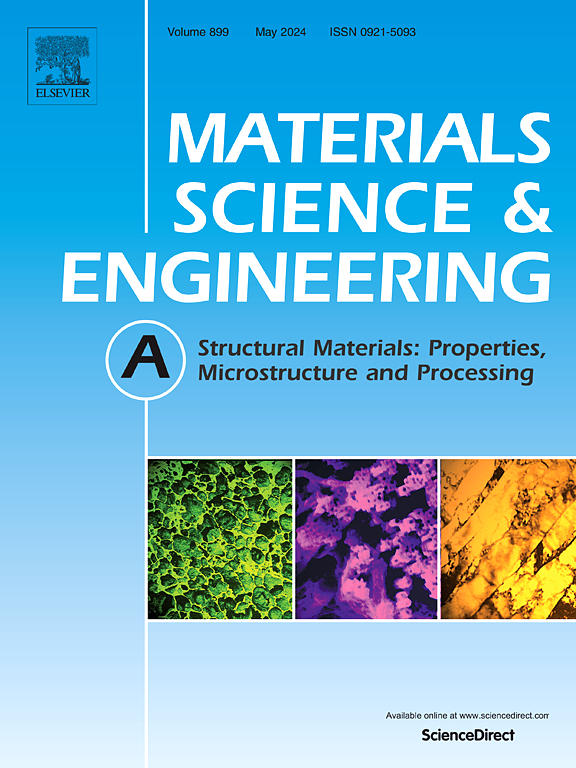单晶NiAlCo合金在冲击压缩下具有优异的动态屈服性能和抗剥落强度
IF 6.1
2区 材料科学
Q1 MATERIALS SCIENCE, MULTIDISCIPLINARY
引用次数: 0
摘要
对材料在动态载荷作用下的力学行为和变形机制的基本理解对于开发优秀的结构材料至关重要。本文主要对单晶NiAlCo在高压应变速率下的动态力学行为、变形机理和损伤特性进行了实验研究。在高脉冲功率发生器CQ-4上,利用磁驱动高速飞片技术测试了NiAlCo单晶合金在10 ~ 50 GPa冲击压力、105/s应变速率下的冲击响应。通过对自由表面速度分布的分析,得到了激波速度与颗粒速度的线性Hugoniot关系,随着激波压力的增加,颗粒强度从2.61 GPa逐渐增加到6.98 GPa。根据Hugoniot弹性极限计算屈服强度,在较宽的冲击压力范围内,屈服强度可达1.80 GPa。在此基础上,用幂指数形式的经验公式描述了动强度与应变率之间的关系。最后,对回收样品进行了详细的透射电镜(TEM)和电子背散射衍射(EBSD)微观表征,揭示了单晶NiAlCo在高压高应变速率下具有丰富的微变形机制,包括位错缠结、高密度层错和lomo - cottrell锁。结果表明:该合金的剥落强度和屈服强度均显著高于大多数合金,表现出优异的力学性能,这可能是多种变形机制耦合作用的结果。本文章由计算机程序翻译,如有差异,请以英文原文为准。
Excellent dynamic yield and spall strength of single crystal NiAlCo alloy under shock compression
A fundamental understanding of the mechanical behaviors and deformation mechanism of materials subjected to dynamic loading is critical for developing outstanding structural materials. This work focuses on the experimental investigation into the dynamic mechanical behaviors, deformation mechanisms, and damage characteristics of single-crystal NiAlCo which was regarded as a potential structure material at high pressure and strain rate. The shock responses of the single-crystal NiAlCo alloy were tested over a range of shock pressure from 10 to 50 GPa at a strain rate of 105/s utilizing the technique of magnetically driven high-velocity flyer plates on high pulsed power generator CQ-4. Based on the analyses of free surface velocity profiles, a linear Hugoniot relationship between shock wave speed and particle velocity was obtained, and the spall strength gradually increased from 2.61 GPa to 6.98 GPa with increasing shock pressure. The yield strength was calculated from the Hugoniot elastic limit, and it reaches 1.80 GPa over the wide range of shock pressure. Further, the relationship between dynamic strength and strain rate was depicted by empirical formulas in power exponential form. Finally, the detailed transmission electron microscopy (TEM) and electron backscatter diffraction (EBSD) microscopic characterization results of recovered samples disclose that single-crystal NiAlCo have abundant micro-deformation mechanisms under high pressure and high strain rate, including dislocation tangle, high-density stacking faults, and Lomer-Cottrell locks. The results show that both spall and yield strength are significantly higher than those of most alloys, exhibiting superior mechanical properties, which may be attributed to the coupling of multiple deformation mechanisms.
求助全文
通过发布文献求助,成功后即可免费获取论文全文。
去求助
来源期刊

Materials Science and Engineering: A
工程技术-材料科学:综合
CiteScore
11.50
自引率
15.60%
发文量
1811
审稿时长
31 days
期刊介绍:
Materials Science and Engineering A provides an international medium for the publication of theoretical and experimental studies related to the load-bearing capacity of materials as influenced by their basic properties, processing history, microstructure and operating environment. Appropriate submissions to Materials Science and Engineering A should include scientific and/or engineering factors which affect the microstructure - strength relationships of materials and report the changes to mechanical behavior.
 求助内容:
求助内容: 应助结果提醒方式:
应助结果提醒方式:


